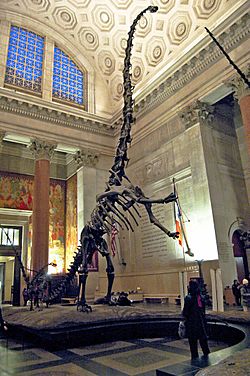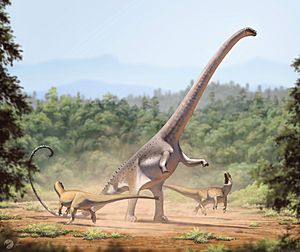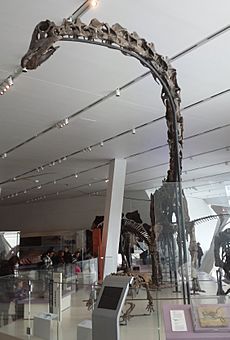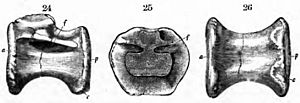Barosaurus facts for kids
Quick facts for kids BarosaurusTemporal range: Upper Jurassic
|
|
|---|---|
 |
|
| A view from below of the rearing Barosaurus mounted in the American Museum of Natural History, New York | |
| Scientific classification | |
| Kingdom: | |
| Class: | |
| Superorder: | |
| Order: | |
| Suborder: | |
| Family: | |
| Genus: |
Barosaurus
|
Barosaurus was a very large, long-necked, plant-eating dinosaur. It lived about 156 to 145 million years ago. The name Barosaurus means "heavy lizard." This giant dinosaur was named by a scientist called Othniel C. Marsh in 1890. Barosaurus fossils have been found in western North America and East Africa.
Barosaurus looked a bit different from its close relative, Diplodocus. It had a longer neck and a shorter tail. However, it was about the same length overall. It was longer than Apatosaurus, but its bones were not as thick or strong. Scientists have not yet found a Barosaurus skull. This is because sauropod skulls are rarely preserved as fossils.
Contents
What was Barosaurus like?

Barosaurus was a truly enormous animal. Some adult Barosaurus were more than 26 meters (85 feet) long. They weighed over 20 metric tons (22 short tons). There are some signs that even larger ones existed. These might have been over 50 meters long and weighed around 100 tons. This would make Barosaurus possibly the largest known dinosaur.
Its close relatives, like Apatosaurus and Diplodocus, had long, flat skulls. Their teeth were like pegs and only at the front of their jaws.
Most of the special features of Barosaurus bones were in its vertebrae. These are the bones that make up the backbone. However, a full backbone has never been found. Diplodocus and Apatosaurus both had 15 neck vertebrae and 10 back vertebrae. Barosaurus had only 9 back vertebrae. It might have had 16 neck vertebrae instead. The neck bones of Barosaurus were similar to Diplodocus. But some were up to 50% longer.
The bony spikes on top of the vertebrae were not as tall or complex in Barosaurus. In contrast, its tail vertebrae were shorter than Diplodocus. This made its tail shorter. The chevron bones under the tail were forked. They had a noticeable spike pointing forward. This was much like its close relative Diplodocus. The tail probably ended in a long whip-like tip. This was similar to Apatosaurus, Diplodocus, and other diplodocids. Some of these had up to 80 tail vertebrae.
The leg bones of Barosaurus were almost the same as Diplodocus. Both walked on four legs. Their strong, pillar-like legs helped support their huge bodies. Barosaurus had front legs that were longer than other diplodocids. Still, they were shorter than most other groups of sauropods. It had one carpal bone in its wrist. The metacarpal bones in its hand were thinner than those of Diplodocus. Barosaurus feet have never been found. But like other sauropods, it would have walked on its toes. All four feet would have had five small toes. A large claw was on the inside toe of the forefoot. Smaller claws tipped the inside three toes of the hindfoot.
How Barosaurus is Grouped
Barosaurus belongs to a family of sauropods called Diplodocidae. Sometimes, it is placed with Diplodocus in a smaller group called Diplodocinae. Diplodocids are known for their long tails with over 70 vertebrae. They also have shorter front legs than other sauropods. They have many special features in their skulls.
Diplodocines, like Barosaurus and Diplodocus, have thinner bodies. They also have longer necks and tails. This is compared to apatosaurines, which are the other group within diplodocids.
Here is a diagram showing how Diplodocinae dinosaurs are related:
| Diplodocinae |
|
||||||||||||||||||||||||||||||||||||||||||||||||||||||
Scientists are learning more about how Diplodocidae dinosaurs are related. Diplodocus has long been thought to be the closest relative of Barosaurus. Barosaurus has only one known species, B. lentus. But Diplodocus has at least three species. Another diplodocid, Seismosaurus, is now often seen as just another species of Diplodocus. Tornieria (once called "Barosaurus" africanus) and Australodocus from Africa have also been grouped with diplodocines.
Discovery and Naming of Barosaurus
The first Barosaurus bones were found in 1889. They were discovered in the Morrison Formation in South Dakota. A woman named Ms. E. R. Ellerman found them. Then, scientists Othniel Charles Marsh and John Bell Hatcher from Yale University dug them up. At first, only six tail vertebrae were found. These became the main example, or type specimen, for the new species. Marsh named it Barosaurus lentus.
The name comes from Greek words: barys meaning "heavy" and sauros meaning "lizard." The Latin word lentus means "slow." The rest of the bones were dug up nine years later, in 1898. These new bones included more vertebrae, ribs, and leg bones.
In 1896, Marsh first put Barosaurus in a group called Atlantosauridae. But in 1898, he correctly placed it with the diplodocids. Marsh also named a second species, Barosaurus affinis, from two smaller foot bones. But scientists now believe this was just another B. lentus.

The most complete Barosaurus lentus skeleton was dug up in 1923. This was at the Carnegie Quarry. Parts of this skeleton were first sent to three different museums. But in 1929, Barnum Brown arranged for all the bones to be sent to the American Museum of Natural History in New York City. They are still there today. A cast of this skeleton is famously displayed in the museum's lobby. It shows the Barosaurus standing up to protect its young from an attacking Allosaurus fragilis. The young dinosaur in the display is now believed to be a different type of dinosaur, Kaatedocus siberi.
More recently, more vertebrae and a hip bone were found in South Dakota. These bones are kept at the South Dakota School of Mines and Technology.

In 2007, a scientist named David Evans found out about a Barosaurus skeleton at the Royal Ontario Museum in Toronto. This skeleton had been dug up in the early 1900s. The museum got it in 1962. But it was never put on display and stayed in storage for 45 years. David Evans found many pieces of the skeleton. Now, it is a main part of the museum's dinosaur exhibit. This skeleton is almost 27.5 meters (90 feet) long. It is the largest dinosaur ever put on display in Canada. About 40% of the skeleton is complete. Since no Barosaurus skull has ever been found, this museum's skeleton has a Diplodocus head.
Discoveries in Africa
In 1907, a German scientist named Eberhard Fraas found two sauropod skeletons in Africa. This was in what is now Tanzania. He first named them Gigantosaurus. But that name was already used. So, in 1911, they were renamed Tornieria. Later, another scientist, Werner Janensch, thought they were the same as the North American Barosaurus.
However, in 1991, one of the African species was found to be a different type of dinosaur called a titanosaur. It was named Janenschia. Many scientists also thought the other African species was different from Barosaurus. In 2006, this was confirmed. The African species, though related to Barosaurus and Diplodocus, is now known as Tornieria africana.
How Barosaurus Lived
Eating Habits
The neck bones of Barosaurus allowed its neck to bend a lot from side to side. But it could not bend its neck much up and down. This suggests that Barosaurus ate differently from other diplodocids. Barosaurus likely swept its long neck in wide arcs along the ground to eat plants. This means it probably did not eat plants that were high up.
Where Barosaurus Lived
Barosaurus fossils are only found in the Morrison Formation. This is a large rock area in the western United States. Scientists use methods like radiometric dating to figure out the age of these rocks. They show that the Morrison Formation rocks were laid down about 155 to 148 million years ago. This was during the Late Jurassic Period.
Barosaurus fossils are found in rocks that are about 150 million years old.
The Morrison Formation was formed in floodplains. These were along the edge of an ancient sea. This sea was connected to the Arctic Ocean. It stretched south into what is now Colorado. As the land to the west rose, the sea moved back north. This happened by the time Barosaurus lived. The dirt and sand in the Morrison Formation came from these western mountains.
During the Late Jurassic, there was a lot of carbon dioxide in the air. This caused high temperatures around the world due to the greenhouse effect. Studies suggest that winter temperatures in western North America could have been around 20°C (68°F). Summer temperatures might have been 40-45°C (104-113°F). These warm temperatures caused a lot of water to evaporate. This, along with mountains blocking rain, led to a dry climate with rain only in certain seasons.
The Morrison Formation is similar in age to other famous fossil sites. These include the Solnhofen Limestone in Germany and the Tendaguru Formation in Tanzania. In 1877, this area became famous for the "Bone Wars." This was a competition between early paleontologists Othniel Charles Marsh and Edward Drinker Cope to find the most fossils.
Scientists think the very long neck of Barosaurus, which was 10 meters (30 feet) long, might have helped it eat over a large area without moving much. It also might have helped the dinosaur get rid of extra body heat. Some scientists also suggest that longer necks might have been attractive to other Barosaurus during mating.
Images for kids
-
A cast of a Barosaurus skull at the Natural History Museum of Utah.
See also
 In Spanish: Barosaurus lentus para niños
In Spanish: Barosaurus lentus para niños





